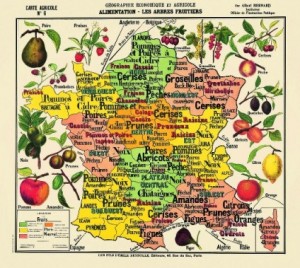I found this great 19th agricultural map of France at Mapping the Marvelous, a feed I’ve only recently subscribed to which is proving a real find. It was linked there to a post about city orchards at a blog called Food Mapping, a “visual exploration and mapping out of the issues surrounding local food, including the associated debates regarding economics, environmentalism, geography, sustainability and taste.” That’s also gone into the feed reader.
New crops tapped by ARS
The USDA’s ARS is apparently optimistic about two new crops they’ve been looking at. Or not so new in one case. Guayule, or Parthenium argentatum, was actually used in pre-Columbian times for its latex. It could also now be a source of bioenergy. And milkweed seems to have a lot of weird uses.
Agrobiodiversity in trouble in Cameroon
Ivo Arrey Mbongaya of the African Centre for Community and Development in Cameroon has a blog on the Eldis Community and has recently discussed threats to two different sorts of agricultural biodiversity in his country. Apparently, goat rearing is in decline, because of the disappearance of grazing land, harsh policies about strays and the lack of veterinary services. He doesn’t say if a local breed is involved, however, and does make reference to “efforts by Heifer Cameroon to distribute cheap animals.”
Also in trouble is “eru,” or Gnetum africanum, a shrub whose leaves are consumed as a green vegetable. Unsustainable harvesting and land use changes are taking their toll, and Ivo recommends taking the plant into domestication.There’s been some work on that by ICRAF and others.
Nibbles: Noodles, Dogs, Found food
- The history of noodles untangled.
- Wolves return, threaten cattle in Spain. Mastiffs have other ideas.
- Found food. Yummie. Mostly.
Nibbles: Indigenous knowledge, Buffalo, Wheat rust, Cassava, New Green Revolution, Environmentalism, Millennium Seedbank, USDA, Pig
- India’s Traditional Knowledge Digital Library a bulwark against piracy. Ahoy me mateys!
- Oh give me a home, where the buffalo-cow hybrid roamed.
- “We’ve found one of the most important disease resistance genes in wheat.”
- Cassava on its way to being a complete meal. Oh joy.
- Usual suspects debate GM.
- The history of the American wilderness movement deconstructed.
- Australia’s Northern Territory needs more collectors.
- “USDA People’s Garden announced today will eliminate 1,250 square feet of unnecessary paved surface at the USDA headquarters and return the landscape to grass.” Michelle likes it.
- Pig domestication, for Vavilov and now.
